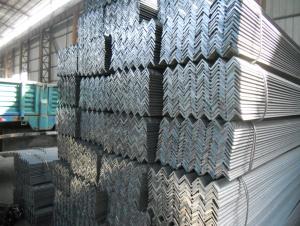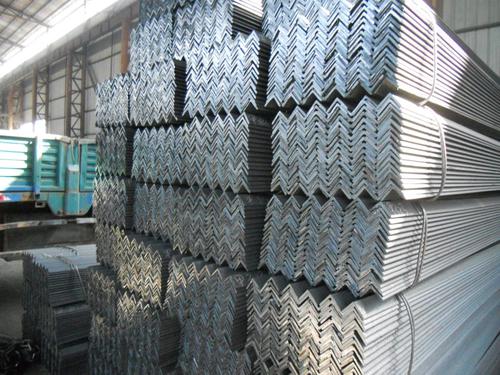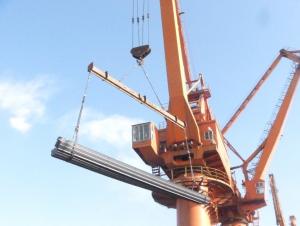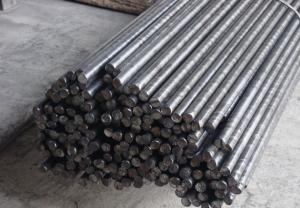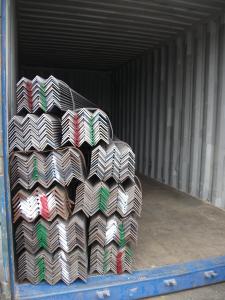GB Standard Steel Angle Bar
- Loading Port:
- China Main Port
- Payment Terms:
- TT OR LC
- Min Order Qty:
- -
- Supply Capability:
- -
OKorder Service Pledge
OKorder Financial Service
You Might Also Like
Specifications of Angle Steel
1. Invoicing on theoretical weight or actual weight as customer request.
2. Length: 6m, 9m, 12m.
3. Sizes:
| Size(mm) | Mass(Kg/m) | Size(mm) | Mass(Kg/m) |
| 75*75*6 | 6.905 | 80*80*6 | 7.376 |
| 75*75*7 | 7.976 | 80*80*7 | 8.525 |
| 75*75*8 | 9.03 | 80*80*8 | 9.658 |
Payment terms:
1).100% irrevocable L/C at sight.
2).30% T/T prepaid and the balance against the copy of B/L.
3).30% T/T prepaid and the balance against L/C.
Material details:
Alloy No | Grade | Element (%) | | ||||
C | Mn | S | P | Si | | ||
| | |||||||
|
|
|
|
|
|
| |
Q235 | B | 0.12—0.20 | 0.3—0.7 | ≤0.045 | ≤0.045 | ≤0.3 | |
|
|
|
|
|
|
| |
Alloy No | Grade | Yielding strength point( Mpa) | | ||||
Thickness (mm) | | ||||||
≤16 | >16--40 | >40--60 | >60--100 | | |||
≥ | | ||||||
|
|
|
|
|
| | |
Q235 | B | 235 | 225 | 215 | 205 | | |
Alloy No | Grade | Tensile strength (Mpa) | Elongation after fracture (%) | | |||
Thickness (mm) | | ||||||
| ≤16 | >16--40 | >40--60 | >60--100 | | ||
≥ | | ||||||
|
|
|
|
|
|
| |
Q235 | B | 375--500 | 26 | 25 | 24 | 23 | |
*If you would like to get our price, please inform us the size, standard/material and quantity. Thank you very much for your attention.
- Q: Can steel angles be used for acoustic isolation or noise barriers?
- While steel angles have the potential to be used for acoustic isolation or noise barriers, their effectiveness may not be on par with materials specifically engineered for this purpose. Sound waves can be somewhat reduced by steel angles through reflection and absorption, but this depends on factors like steel thickness, density, and barrier design. It's worth noting that steel angles are not typically intended for soundproofing, so relying solely on them may not yield optimal acoustic isolation. To achieve optimal results, it is advised to explore specialized materials and techniques exclusively designed for noise barriers.
- Q: What are the different methods of surface protection for steel angles?
- There are several different methods of surface protection for steel angles, each with its own advantages and disadvantages. 1. Painting: One of the most common methods of surface protection is painting. This involves applying a layer of paint to the steel angle to create a barrier between the steel and the surrounding environment. Paint can provide both aesthetics and protection against corrosion. However, it may require regular maintenance and can be prone to chipping or peeling over time. 2. Galvanization: Galvanization is a process where a layer of zinc is applied to the surface of the steel angle. This creates a protective barrier that helps prevent corrosion. Galvanization can be done through either hot-dip galvanizing or electro-galvanizing. Hot-dip galvanizing involves immersing the steel angle in a bath of molten zinc, while electro-galvanizing uses an electrical current to deposit zinc onto the surface. Galvanized steel angles are highly resistant to rust and can provide long-lasting protection. 3. Powder coating: Powder coating is a dry finishing process where a fine powder is electrostatically applied to the surface of the steel angle. The powder is then cured under heat to form a hard, durable coating. Powder coating provides excellent protection against corrosion, impacts, UV rays, and chemicals. It also offers a wide range of color options and a smooth, attractive finish. However, it can be more expensive than other methods and requires specialized equipment for application. 4. Epoxy coating: Epoxy coatings are a type of protective finish made from epoxy resins. These coatings are highly resistant to chemicals, impacts, and abrasions. They provide a tough, glossy finish that can withstand harsh environments. Epoxy coatings are typically applied through a two-part system, where a resin and a hardener are mixed together before being applied to the steel angle. While epoxy coatings provide excellent protection, they can be more expensive and time-consuming to apply. 5. Metal plating: Metal plating involves covering the steel angle with a layer of metal such as chrome, nickel, or zinc. This provides a decorative finish as well as protection against corrosion. Metal plating can be done through electroplating or electroless plating processes. Electroplating uses an electrical current to deposit a thin metal layer onto the surface, while electroless plating does not require electricity and utilizes a chemical reaction to achieve the plating. Metal plating can enhance the appearance and durability of steel angles, but it may not be as effective in highly corrosive environments.
- Q: What are the standard sizes of steel angles?
- The standard sizes of steel angles can vary depending on the region and industry, but there are some common sizes that are widely used. In general, steel angles come in equal leg and unequal leg sizes. For equal leg angles, the standard sizes range from 20x20mm to 200x200mm, with thicknesses ranging from 3mm to 26mm. Unequal leg angles typically have one leg longer than the other, and their standard sizes range from 25x16mm to 200x150mm, with thicknesses ranging from 3mm to 15mm. These standard sizes are commonly used in construction, engineering, and manufacturing industries for various applications, such as structural supports, framing, and bracing. It's important to note that these sizes may vary depending on the specific requirements of a project or the standards set by the governing bodies within the industry.
- Q: How do you calculate the maximum allowable deflection for a steel angle beam?
- To calculate the maximum allowable deflection for a steel angle beam, you need to consider several factors. The maximum allowable deflection is typically determined by the design code or standard being followed. Here is a general approach to calculate this deflection: 1. Determine the properties of the steel angle beam: Gather information such as the cross-sectional dimensions, moment of inertia, and modulus of elasticity of the steel angle beam. These properties can be obtained from the manufacturer's literature or through calculation. 2. Determine the applicable design code or standard: Different design codes or standards may have different criteria for allowable deflections. Examples include the American Institute of Steel Construction (AISC) Manual, Eurocode, or British Standards. Identify the relevant code for your project. 3. Identify the beam's support conditions: Determine whether the steel angle beam is simply supported or fixed at its ends. The support conditions will affect the maximum allowable deflection calculation. 4. Calculate the maximum allowable deflection: Use the appropriate formula or equation from the design code or standard to calculate the maximum allowable deflection. This formula will typically depend on the span length, beam properties, and support conditions. 5. Apply any additional factors or limitations: Some design codes or standards may introduce factors or limitations based on the specific application or load conditions. Consider any additional factors or limitations specified in the code and incorporate them into the calculation. 6. Compare the calculated deflection with the maximum allowable deflection: Once you have calculated the maximum allowable deflection using the relevant formula and considered any additional factors, compare it with the calculated deflection of the steel angle beam under the intended load conditions. If the calculated deflection is within the maximum allowable deflection, the design is considered acceptable. Otherwise, adjustments to the beam properties or design may be necessary. It is important to note that the above steps provide a general guideline for calculating the maximum allowable deflection for a steel angle beam. The specific calculation method may vary depending on the design code or standard being followed, so it is crucial to consult the applicable code or seek professional guidance for accurate and reliable results.
- Q: How do you calculate the effective length of a steel angle?
- To calculate the effective length of a steel angle, you need to consider its end conditions and support conditions. It is determined by analyzing the buckling behavior and stability of the angle under different loading conditions. This involves considering factors such as fixed or pinned ends, bracing conditions, and the angle's geometric properties. By applying relevant formulas or structural analysis methods, you can determine the effective length and use it to assess the angle's structural stability and design requirements.
- Q: What is the maximum spacing for steel angles in a support structure?
- The maximum spacing for steel angles in a support structure depends on several factors including the load being supported, the size and thickness of the angles, and the specific design criteria. In general, the spacing between steel angles should be determined by the structural engineer or designer based on the maximum allowable deflection and stress criteria for the given application. Steel angles are commonly used in support structures due to their high strength and versatility. They can provide structural stability and support to various types of loads. However, excessive spacing between steel angles can lead to increased deflection and stress on the structure, potentially compromising its integrity. To determine the maximum spacing, the engineer will consider the load-bearing capacity of the steel angles, the anticipated load distribution, and any applicable building codes or industry standards. The specific design criteria will dictate the allowable deflection and stress limits, which will then be used to calculate the appropriate spacing between the angles. It is important to note that different types of support structures may have different maximum spacing requirements. For instance, in a roof truss system, the maximum spacing between steel angles may be smaller compared to a mezzanine support structure. Additionally, the maximum spacing may vary depending on whether the angles are used as primary or secondary support members. Ultimately, the maximum spacing for steel angles in a support structure should be determined through a thorough engineering analysis, taking into account the specific project requirements and safety factors. It is always recommended to consult with a structural engineer or design professional to ensure the support structure meets all necessary criteria for safety and performance.
- Q: How are steel angles protected against corrosion?
- There are various techniques available to protect steel angles from corrosion. One commonly used method entails applying a protective coating. This can be accomplished by either painting the steel angles with a paint that resists corrosion or by employing galvanization, which involves immersing the steel angles in molten zinc to create a protective layer on the surface. Another approach to prevent corrosion in steel angles is the application of a corrosion inhibitor. This involves introducing chemicals or compounds to the steel angles that impede or decelerate the corrosion process. Additionally, conducting regular inspections and performing proper maintenance can aid in detecting and addressing any indications of corrosion before they result in significant damage.
- Q: How are steel angles protected against fire damage?
- Fire-resistant coatings and fireproofing materials are commonly used to protect steel angles from fire damage. These measures aim to prevent or delay the steel from reaching its critical temperature, which can compromise its structural integrity. One popular method of safeguarding steel angles involves applying intumescent coatings. These coatings expand when exposed to high temperatures, creating a protective char layer that insulates the steel and slows down heat transfer. This process effectively hinders the steel from rapidly increasing in temperature, thus enhancing its fire resistance capabilities. Another approach is to utilize fireproofing materials, such as concrete or gypsum-based sprays or boards. These materials act as a barrier between the steel angles and the fire, providing insulation and preventing the heat from reaching the steel. Fireproofing materials are commonly employed in buildings with higher fire resistance requirements, such as tall buildings or industrial facilities. In certain cases, steel angles can be enclosed within fire-rated enclosures for added protection. This entails enclosing the steel angles within fire-rated walls, floors, or ceilings made of materials with exceptional fire resistance properties. These enclosures effectively isolate the steel angles from potential fire sources, adding an extra layer of defense. It is important to acknowledge that the specific fire protection measures for steel angles can vary based on building codes, fire safety regulations, and the intended use of the structure. Consulting with fire protection engineers and adhering to the appropriate guidelines will ensure that the steel angles are adequately shielded against fire damage.
- Q: What is a steel angle?
- A steel angle is a type of structural steel shape that has two legs of equal length, forming a 90-degree angle. It is commonly used in construction and various industries for providing structural support and reinforcement.
- Q: Are steel angles suitable for earthquake-prone areas?
- Yes, steel angles are suitable for earthquake-prone areas. Steel is a strong and durable material that can withstand seismic forces and provide structural stability during earthquakes. The use of steel angles helps distribute the load and reinforce the structure, making it more resistant to seismic activity.
Send your message to us
GB Standard Steel Angle Bar
- Loading Port:
- China Main Port
- Payment Terms:
- TT OR LC
- Min Order Qty:
- -
- Supply Capability:
- -
OKorder Service Pledge
OKorder Financial Service
Similar products
Hot products
Hot Searches
Related keywords
